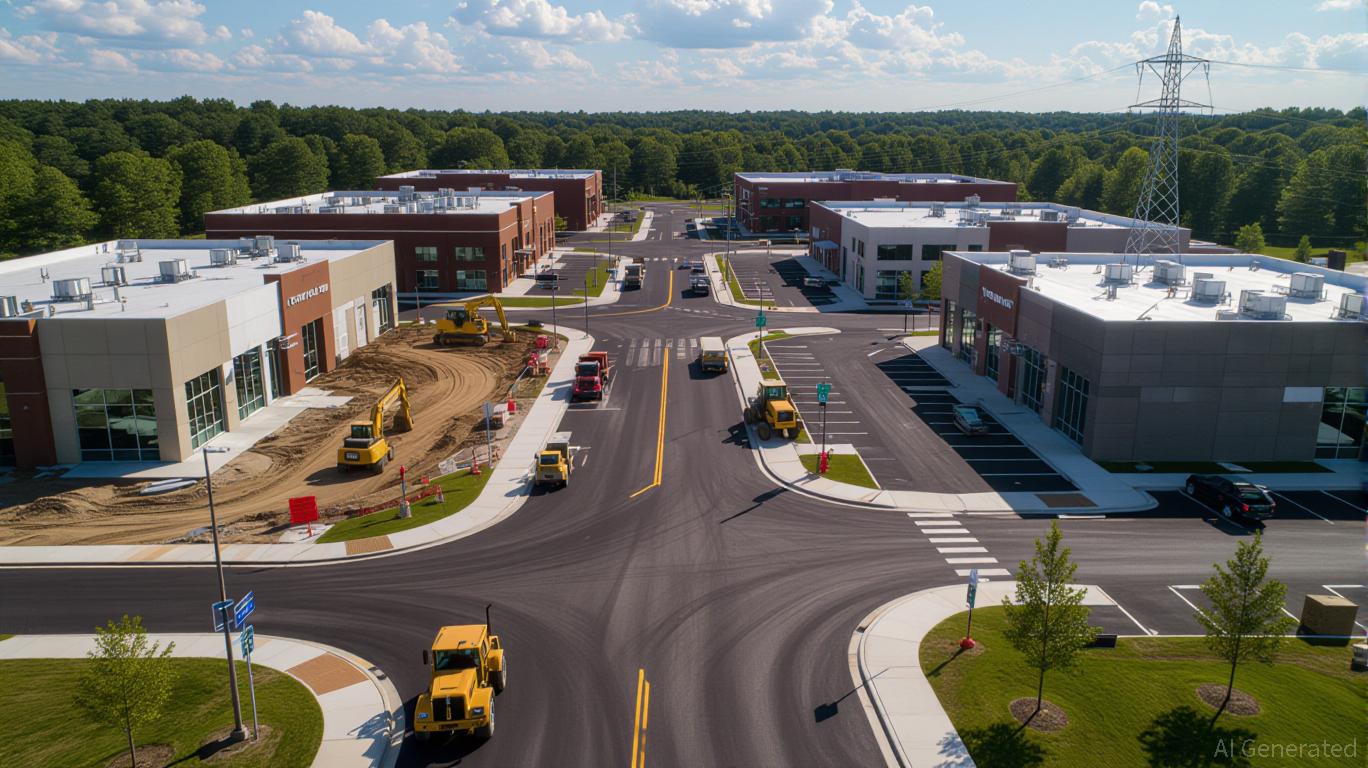The Influence of Targeted Infrastructure Funding on Property and Industrial Growth
- New York's FAST NY program allocates $9.8M to Webster for infrastructure upgrades, targeting industrial and real estate growth. - The grant funds road realignment, sewer upgrades, and electrical planning to attract $650M private investments like fairlife® dairy facility. - Webster's 10.1% residential property value surge and 300+ acres of revitalized land highlight infrastructure-driven economic multipliers. - Statewide, FAST NY has allocated $283M across 37 projects, transforming coal plants and brownfi
Strategic Infrastructure Investment: Driving Private Sector Growth
Amidst economic volatility and evolving industrial landscapes, targeted infrastructure spending has become a powerful catalyst for stimulating private sector expansion. A recent example is the $9.8 million FAST NY grant awarded to Webster, NY, which demonstrates how focused public investment can spark significant transformation in both real estate and industry. By exploring this initiative, we can better understand how infrastructure grants have the potential to reshape local economies and attract substantial private capital.
Preparing Land for Immediate Development

The FAST NY Shovel-Ready Grant Program, managed by Empire State Development, aims to accelerate the readiness of industrial sites for private enterprise. In Webster, the $9.8 million grant is being used to rejuvenate the former Xerox campus and surrounding areas through projects such as road redesign, upgrades to sanitary sewers, and planning for electrical infrastructure. These enhancements address core obstacles to development, including outdated utilities and limited transportation options, which often discourage fast-growing industries from investing.
This focus on preparing "shovel-ready" sites is especially important in today’s competitive market. By ensuring land is pre-approved and prepped for development, governments help reduce both the time and expense for businesses to set up operations. Webster is already seeing results: a $650 million fairlife® dairy facility, projected to generate 250 jobs, is scheduled to open by the end of 2025. This project highlights how infrastructure improvements can directly encourage private investment, particularly in sectors that require significant capital, such as advanced manufacturing and food production.
Wider Economic Benefits: Employment, Property Values, and Tax Revenue
The positive effects of these grants extend well beyond immediate job creation. In Webster, residential property values have climbed by 10.1% over the past year, a surge attributed to the area’s improved industrial prospects and upgraded infrastructure. Commercial real estate is also thriving, with nearly 300 acres of previously underused land now available for development, according to recent reports. This dual impact on both residential and commercial markets underscores the interconnected benefits of infrastructure-led growth.
Additionally, the FAST NY program’s support for mixed-use zoning—which blends manufacturing, logistics, and residential spaces—helps build sustainable economic communities. By reducing commuting distances and establishing local employment centers, these projects improve quality of life and help attract both talent and investment. For example, the revitalization of the Xerox campus includes plans for advanced manufacturing and semiconductor supply chain operations, aligning with the global demand for technology-driven industries.
Expanding the FAST NY Model Statewide
Webster’s progress is part of a broader trend. Since its launch, the FAST NY program has distributed over $283 million across 37 projects, revitalizing nearly 7,700 acres of industrial land throughout New York State. In Oneida County, a $32.36 million grant is supporting a site for Chobani’s $1 billion expansion, while Broome County’s $11.3 million investment is converting a former coal plant into a logistics center, according to official sources. These cases show that the program’s approach—combining infrastructure improvements with incentives for private industry—can be successfully replicated to drive growth in various regions.
Governor Kathy Hochul’s focus on developing "shovel-ready" sites reflects a strategic understanding of modern industrial requirements. By emphasizing energy-efficient utilities, robust transportation links, and scalable infrastructure, New York is positioning itself as a destination for high-tech manufacturing and clean energy projects. This strategy not only attracts major employers but also creates opportunities for smaller businesses and startups, further diversifying local economies.
Looking Ahead: Building Resilient Economies
The experience in Webster, along with the wider FAST NY initiative, illustrates that infrastructure grants are more than just financial support—they are essential tools for building resilient economies. By removing physical and regulatory barriers to development, these investments create an environment where private innovation can thrive. As global supply chains adapt and industries seek greater resilience, regions that embrace this forward-thinking model will be better positioned to compete.
For both investors and policymakers, the takeaway from Webster is clear: strategic infrastructure funding is fundamental to long-term, inclusive growth. It transforms neglected sites into engines of progress, converting public investment into private sector returns and fostering broad-based economic development. In a connected world, the ability to seize such opportunities will shape the future of industrial and real estate success.
Disclaimer: The content of this article solely reflects the author's opinion and does not represent the platform in any capacity. This article is not intended to serve as a reference for making investment decisions.
You may also like
Shiba Inu’s Focus on Privacy Aims to Draw DeFi Interest Amid Price Challenges
- Shiba Inu (SHIB) stabilizes near $0.00000851, with traders monitoring $0.000008390 support and $0.000008840 resistance amid a descending channel pattern since early 2025. - A 1.7% weekly gain contrasts with a 17.4% drop from its 14-day high, while $132.8M trading volume highlights uncertainty despite a privacy-focused Shibarium upgrade integrating Zama's FHE technology. - Technical indicators show fragile equilibrium, with bearish EMAs and $380K net outflows reinforcing distribution trends, though analys

Bitcoin News Update: Greenidge Transitions to AI as Bitcoin Mining Faces Rising Expenses and Regulatory Challenges
- Greenidge Generation , a Bitcoin miner, shifts to AI/HPC amid industry cost and regulatory pressures. - Bitcoin mining profitability declines as hashrate hits 1.16 ZH/s and hash prices fall below $35. - Companies like Bitfarms abandon Bitcoin for AI/HPC, while CleanSpark reports $766M mining revenue surge. - Regulatory scrutiny intensifies over foreign mining hardware, with BlockQuarry promoting domestic alternatives. - Energy costs and debt disputes force Tether to halt Uruguayan mining, highlighting se

Bitcoin News Update: Institutions Favor Bitcoin's Reliability as Altcoin Growth Slows
- Bitcoin's market dominance exceeds 54%, driven by waning altcoin momentum and institutional preference for stability. - Altcoin Season Index at 23 signals Bitcoin-centric trends as macroeconomic pressures and regulatory uncertainty weaken alternative cryptocurrencies. - Institutional investors prioritize Bitcoin's scalability and infrastructure, exemplified by Bhutan's Ethereum integration and Bitcoin Munari's fixed-supply presale model. - Analysts highlight Bitcoin's role as a macroeconomic barometer, w
MMT Token TGE: Is This the Dawn of a New Era for Digital Asset Foundations?
- MMT Token's 2025 TGE secured $100M valuation from Coinbase Ventures, OKX, and Jump Crypto, with 1330% price surge post-launch. - Momentum DEX on Sui reported $13B trading volume and $320M TVL, leveraging CLMM architecture and cross-chain RWAs for institutional appeal. - 55% of hedge funds now hold digital assets, driven by U.S. CLARITY Act and EU MiCA 2.0, as MMT's RWA focus bridges traditional and blockchain finance. - Despite macroeconomic risks like 34.6% post-TGE volatility, MMT's governance model an
